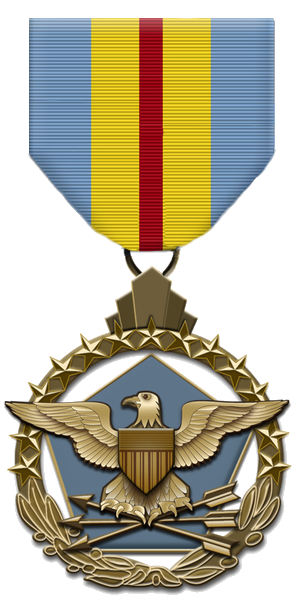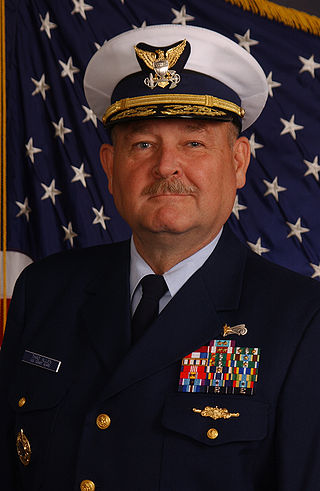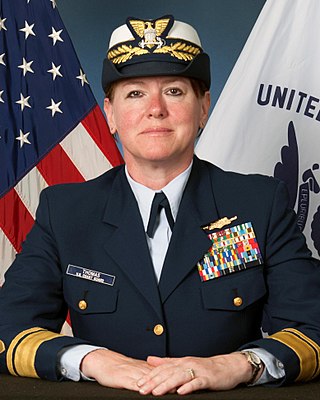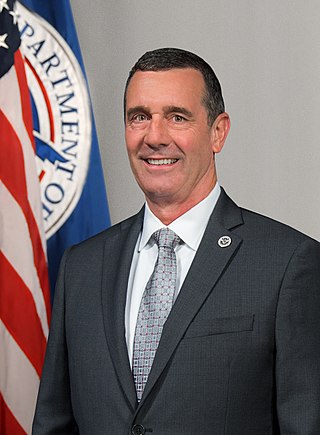
The Bronze Star Medal (BSM) is a United States Armed Forces decoration awarded to members of the United States Armed Forces for either heroic achievement, heroic service, meritorious achievement, or meritorious service in a combat zone.

The Defense Distinguished Service Medal is a military decoration of the United States Department of Defense, which is presented to United States Armed Forces service members for exceptionally distinguished performance of duty contributing to the national security or defense of the United States. The medal was created on July 9, 1970, by President Richard Nixon in Executive Order 11545. President Nixon awarded the first medal, on the day the Executive Order was signed, to General Earle Wheeler, who was retiring from the US Army after serving as Chief of Staff of the United States Army and then Chairman of the Joint Chiefs of Staff.

The Legion of Merit (LOM) is a military award of the United States Armed Forces that is given for exceptionally meritorious conduct in the performance of outstanding services and achievements. The decoration is issued to members of the eight uniformed services of the United States as well as to military and political figures of foreign governments.

The United States Coast Guard (USCG) is the maritime security, search and rescue, and law enforcement service branch of the United States Armed Forces and one of the country's eight uniformed services. The service is a maritime, military, multi-mission service unique among the United States military branches for having a maritime law enforcement mission with jurisdiction in both domestic and international waters and a federal regulatory agency mission as part of its duties. It is the largest coast guard in the world, rivaling the capabilities and size of most navies.

The Joint Chiefs of Staff (JCS) is the body of the most senior uniformed leaders within the United States Department of Defense, which advises the president of the United States, the secretary of defense, the Homeland Security Council and the National Security Council on military matters. The composition of the Joint Chiefs of Staff is defined by statute and consists of a chairman (CJCS), a vice chairman (VJCS), the chiefs of the Army, Marine Corps, Navy, Air Force, Space Force, and the chief of the National Guard Bureau. Each of the individual service chiefs, outside their JCS obligations, works directly under the secretaries of their respective military departments, e.g. the secretary of the Army, the secretary of the Navy, and the secretary of the Air Force.

The Defense Superior Service Medal (DSSM) is a military decoration of the United States Department of Defense, which is presented to United States Armed Forces service members who perform superior meritorious service in a position of significant responsibility.

The Transportation Distinguished Service Medal was the highest decoration which could be bestowed by the Secretary of Transportation for exceptional service to the United States government in a position of great responsibility to a member of the United States Coast Guard. In 2003 it was replaced by the Homeland Security Distinguished Service Medal.

The United States Coast Guard Auxiliary is the uniformed, non-military volunteer component of the United States Coast Guard. Congress established the unit on 23 June 1939, as the United States Coast Guard Reserve. On February 19, 1941, the entity was renamed the United States Coast Guard Auxiliary. The Auxiliary's purpose is to bolster all USCG undertakings both at sea and in the sky, with the exception of tasks necessitating "direct" law enforcement or military actions. As of 2022, the U.S. Coast Guard Auxiliary boasted around 21,000 members.

The Coast Guard Distinguished Service Medal (CGDSM) is a military decoration of the United States Coast Guard that was established 4 August 1949 and is presented to coast guardsmen for "Exceptionally meritorious service to the government in a duty of great responsibility." Prior to this date, members of the Coast Guard were eligible to receive the Navy Distinguished Service Medal. The Homeland Security Distinguished Service Medal, which replaced the Transportation Distinguished Service Medal in 2002, is another higher precedence Distinguished Service Medal that may be awarded to Coast Guardsmen. The Coast Guard Distinguished Service Medal is equivalent to the Army's Army Distinguished Service Medal, Naval Service's Navy Distinguished Service Medal, and the Air and Space Forces' Air Force Distinguished Service Medal.

The Gold Lifesaving Medal and Silver Lifesaving Medal are U.S. decorations issued by the United States Coast Guard. The awards were established by Act of Congress, 20 June 1874; later authorized by 14 U.S.C. § 500. These decorations are two of the oldest medals in the United States and were originally established at the Department of Treasury as Lifesaving Medals First and Second Class. The Department of the Treasury initially gave the award, but today the United States Coast Guard awards it through the Department of Homeland Security. They are not classified as military decorations, and may be awarded to any person.

John William Kime was an admiral of the United States Coast Guard who served as the 19th commandant from 1990 to 1994.
The United States military inter-service awards and decorations are those medals and ribbons which may be awarded to all members of the six military branches of the U.S. Armed Forces. Each military department awards inter-service awards under the same criteria.

Thad William Allen is a former admiral of the United States Coast Guard who served as the 23rd commandant from 2006 to 2010. Allen is best known for his performance directing the federal response to hurricanes Katrina and Rita in the Gulf Coast region from September 2005 to January 2006, and for his role as National Incident Commander of the Unified Command for the Deepwater Horizon oil spill in the Gulf of Mexico in 2010. Robert J. Papp Jr. succeeded him as Commandant on 25 May 2010.
This article covers the organization of the United States Coast Guard.

Admiral Robert Joseph Papp Jr. is a retired admiral of the United States Coast Guard who served as the 24th commandant from 2010 to 2014. He led the largest component of the United States Department of Homeland Security, with 42,000 active duty, 8,200 Reserve, 8,000 civilian, and 31,000 Auxiliary personnel.

Jody A. Breckenridge is a former commander of the U.S. Coast Guard's Pacific Area.

John C. Acton is a retired United States Coast Guard rear admiral who served as the Director of Operations Coordination for DHS. Acton formerly served as Director of the DHS Presidential Transition Team.

Cari Batson Thomas is a retired rear admiral of the United States Coast Guard and a 1984 graduate of the U. S. Coast Guard Academy. On January 22, 2010, Thomas became the third female commander of USCG Training Center Cape May to be advanced to a flag officer. Her final assignment was Assistant Commandant for Human Resources at the Coast Guard Academy.

David Peter Pekoske is an American government official and retired U.S. Coast Guard vice admiral who has served as the seventh administrator of the Transportation Security Administration in the United States Department of Homeland Security (DHS) since 2017. He served as the acting deputy secretary of Homeland Security from April to November 2019 and again from January to June 2021. From January 20, 2021 to February 2, 2021 he served as acting secretary of homeland security, during the Senate confirmation of Alejandro Mayorkas. Pekoske retired with 33 years of active military service in 2010 as the 26th vice commandant of the Coast Guard.

Paul Frederick Zukunft is a retired admiral of the United States Coast Guard who served as the 25th commandant. He was confirmed by the U.S. Senate as the Commandant, with the rank of admiral, in May 2014 and relieved Robert J. Papp Jr. as commandant on 30 May 2014. Prior to his selection as Commandant, he served as Commander, Coast Guard Pacific Area. In this position, Zukunft was the operational commander for all U.S. Coast Guard missions within the half of the world that ranges from the Rocky Mountains to the waters off the East Coast of Africa. He concurrently served as Commander, Defense Force West and provided U.S. Coast Guard mission support to the U.S. Department of Defense and Combatant Commanders.



















